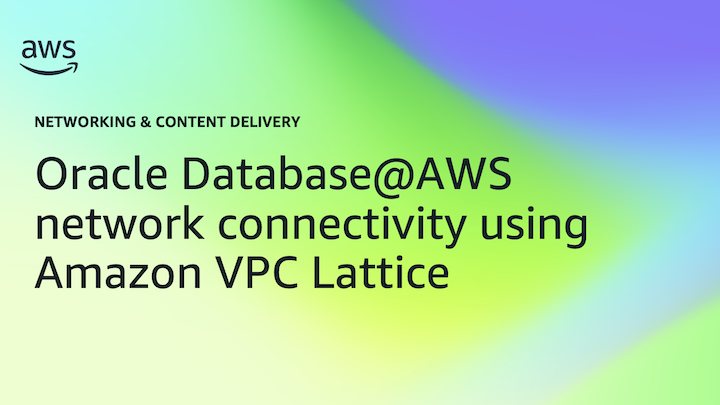Networking & Content Delivery
Amazon VPC Lattice support for RDS Multi-AZ
In this post we review how Amazon VPC Lattice can provide simple and secure access to an Amazon RDS Multi-AZ deployment using Amazon Resource Names (ARNs). Prerequisites We assume you are familiar with Amazon Virtual Private Cloud (VPC), and VPC Lattice concepts and capabilities. If you are unfamiliar with VPC Lattice please review Amazon VPC […]
Oracle Database@AWS network connectivity using Amazon VPC Lattice
As Oracle Database (ODB)@AWS becomes generally available, we’re introducing new network connectivity capabilities that streamline connectivity between Oracle Exadata infrastructure (managed by OCI) inside Amazon Web Services (AWS) data centers and users’ AWS and on-premises networks. These new features include Amazon VPC Lattice integrations for hybrid connectivity from ODB networks, and native secure access between […]
Boost application performance: Amazon CloudFront enables HTTPS record
Amazon CloudFront announced support for Amazon Route 53 HTTPS DNS alias record across its global network, enabling clients to discover the optimal HTTP protocol during the initial DNS resolution phase rather than in a subsequent connection step. This helps users improve performance and security, and simultaneously reduce operational expenses. This post explores the implementation details, […]
Scaling your hybrid DNS setup with Amazon Route 53 Resolver endpoint metrics
This post demonstrates how to use a new Amazon CloudWatch metric for Amazon Route 53 Resolver endpoints to make informed scaling decisions. We show you how to monitor Resolver Networking Interface (RNI) capacity and implement a scalable architecture that makes sure of reliable DNS resolution across your hybrid infrastructure. As organizations expand their hybrid cloud […]
Building secure multicloud access with AWS Client VPN and AWS Site-to-Site VPN
In today’s rapidly evolving cloud landscape, organizations are increasingly adopting multicloud strategies for several compelling reasons. Following mergers and acquisitions, companies need to integrate and maintain existing cloud solutions from both organizations. Different business units within an organization often have varying technical requirements and expertise, leading them to prefer specific cloud providers. For highly regulated […]
Addressing private IPv4 exhaustion with AWS Cloud WAN service insertion
In this post, we describe how you can use Amazon Web Services (AWS) Cloud WAN with service insertion to centralize your private NAT Gateways and PrivateLink to effectively and efficiently address private IPv4 exhaustion. We demonstrate how you can maximize the usage of available IP space while minimizing cost impact. Private IPv4 space, defined in […]
Securing Service Communications: Combining VPC Lattice with Network Firewall
Introduction: Organizations building modern applications in AWS often need different security controls for various types of service communications. While centralized inspection using AWS Network Firewall has been the traditional approach for securing service-to-service traffic, it presents challenges as applications scale. Managing static firewall rules is operationally complex, especially for Layer 7 traffic, and troubleshooting becomes […]
Introducing security group referencing and enhanced DNS support for AWS Cloud WAN
In this post we cover the recently launched feature of security group referencing and enhanced DNS support on AWS Cloud WAN. This new feature allows you to create inbound security rules referencing security groups defined in other Amazon Virtual Private Clouds (Amazon VPCs) attached to an AWS Cloud WAN within the same AWS Region and […]
Introducing new application layer (L7) DDoS protections for AWS WAF and AWS Shield Advanced customers
As the global threat landscape shifts and evolves, AWS services that help protect our customers from those threats also evolve to meet their needs. One type of threat that has changed considerably over the past few years is Distributed Denial of Service (DDoS). DDoS attacks have evolved from targeting lower network layers (Layers 3 and […]
Design and build IPv6 internet inspection architectures on AWS
As organizations increasingly adopt IPv6 to address public IPv4 exhaustion, private IPv4 scarcity—especially in large-scale networks—and the need to support IPv6-only clients, securing both IPv4 and IPv6 traffic becomes critical. We can apply consistent traffic inspection for inbound and outbound flows in Amazon Virtual Private Clouds (Amazon VPCs) to maintain security. In this post, we […]









